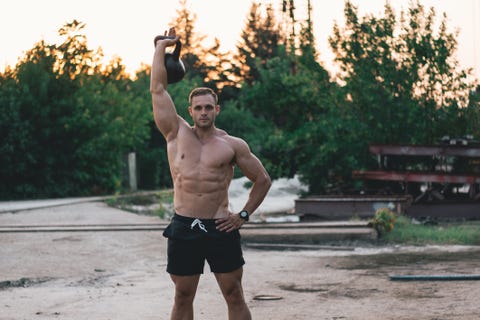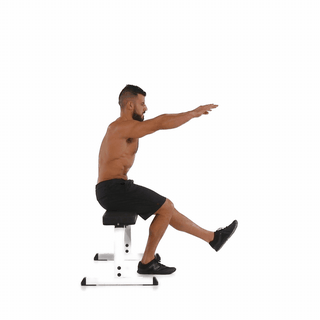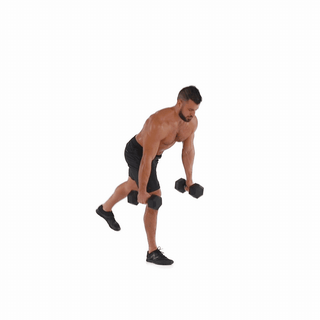If your idea of unilateral training is to toss a few single-arm or single-leg exercises into your workout as an afterthought, you’re probably not reaping their full strength-building, injury-proofing benefits.
Most (if not all) of us are asymmetrical, meaning one limb will almost always be bigger and stronger than the other. That muscle imbalances become most obvious when one limb has to support weight on its own during those unilateral movements (think: single-leg squats and one-arm presses), but if they’re too extreme, the disparities can sneak into bilateral exercises as well (think: back squats and pushups).
For example, even if both arms have to work to push you up off the floor, you’re probably using more of one than the other—without even realizing it. “It’s very rare for somebody to have 50-50 weight distribution because almost everyone has a dominant limb,” says Joel Seedman, Ph.D., owner of Advanced Human Performance and author of Movement Redefined.
Why You Should Use Unilateral Exercises
You’ll probably never achieve perfect symmetry between both sides of your body, unfortunately—that’s just part of our makeup. That said, you should try to get as close to even as possible, especially if you’re shooting for a developed physique. “The more symmetrical we are, the fewer imbalances and compensation patterns we have,” Seedman explains. The result: Greater overall strength and efficiency, as well as a reduced likelihood of injury.
Take the back squat for example. When you squat with muscle imbalances, your chance of injuring your back, knees or hips is markedly increased. Instead of generating force straight up through your core, that force pulls on the body in uneven positions and directions, according to Seedman.
Similarly, running with strength imbalances can up your risk of injury. A 2005 study published in Clinical Journal of Sport Medicine found that runners with single-leg overuse injuries had noticeable strength imbalances between the hip muscles on their injured and non-injured side. Whether the injuries were the cause or the result of the muscle imbalances is unknown—but researchers suggest these findings show a relationship between the two.
If you can eliminate those imbalances, each limb will be able to handle weight more evenly, which only helps make you stronger and more efficient in bilateral movements, Seedman says.
You can try to even yourself out during bilateral exercises, but it’s pretty hard to get both sides to fire equally unless each is forced to learn how to fend for itself. “Otherwise, you’re going to revert back to those compensation patterns,” Seedman says. So, if you care about getting stronger and minimizing your injury risk, unilateral exercises (like single-leg squats, single-leg Romanian deadlifts and one-arm presses) are a must.
Bonus: Most guys don’t realize that single-arm exercises in particular do double-duty as major core-builders. If you do a single-arm chest press, for example, your core has to fire like crazy to keep you from rolling off the bench, according to Seedman. One of his favorite core-crushing, symmetry-building moves is the single-arm eccentric accentuated dumbbell push press.
4 Tips to Maximize Unilateral Exercises

Andrija NikolicGetty Images
Keep this advice in mind next time you hit the gym, and your gains—and muscle balance—will soon follow. Instead of blowing through a set of lunges or single-arm presses and calling it a day, incorporate these tips to maximize strength and stability.
1. Do unilateral exercises first
“Some people just kind of assume you do the heavy bilateral lift first and then you do the unilateral, but there’s no reason you can’t do it the other way around,” says celebrity trainer Ben Bruno.
Starting your workout with unilateral exercises is actually a great way to activate muscles that would normally be a little lazy during your bilateral exercises. Sure, you run the risk of fatiguing your muscles before your big lift, but Seedman thinks there could be some warmup element at play. “ You may actually be able to lift more weight because the muscles are firing better and more symmetrically,” he says.
Even better, Seedman believes you’ll be less likely to fall back into old compensation patterns where your stronger side picks up the slack.
2. Do ‘true’ unilateral exercises
Lunges and Bulgarian split squats are great, but you can make the argument that they’re not ‘true’ unilateral exercises.
“You’re actually still using both legs when doing those movements,” Seedman says. “When you do something like a lunge, chances are when you do the exercise on both sides, one leg may dominate a little bit.”


Men’s Health
So, be sure to include ‘true’ unilateral exercises in your routine, like single-leg Romanian deadlifts, single-leg squats, skater squats, step-ups and single-leg hip thrusts, to name a few.
3. Pause before switching sides
Bruno recommends treating each group of reps using each limb as an individual set—especially when you go heavy. “Anybody who’s done a heavy set of lunges or Bulgarian split squats knows it’s very taxing,” he says.
If you move straight from one side to the other when you’re still huffing and puffing, your form might break down before you end your set, and you won’t reap the full strength and stability benefits. Don’t hesitate to hit pause if you need to. “I think it just helps to take a little break, both from a breathing standpoint, and if you’re holding dumbbells, from a grip standpoint,” Bruno says.
According to Seedman, you’ll probably only need 15 seconds of rest between sides—but if you’re going heavy or you’re especially fatigued, you may need a full minute.
4. Start lighter
Unilateral exercises—especially single-leg—can be humbling, because you probably won’t be able to use a ton of weight at first. But if you go too heavy too soon, Bruno warns that you’ll have a hard time keeping your balance.


Men’s Health
Resist the urge to load up your single-leg squats and deadlifts right away. Your first priority is to master the move and get used to balancing on one leg. Then, you can start adding weight.
Source: Read Full Article
